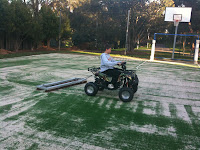When I was contacted this past week by someone representing the Synthetic Turf Council, I was a little skeptical. Can something mostly made from oil-based material—synthetic turf—be environmentally advantageous? Turns out a strong environmental case can be made for using synthetic turf instead of natural grass—especially in areas of the country where water is scarce....... In fact, according to Rick Doyle, president of the Atlanta-based Synthetic Turf Council, if one is pursuing LEED certification for a new or existing building, using synthetic turf can help one earn from six to 14 points (Water Efficient Landscaping, Recycled Content, Rapidly Renewable Material, Innovation in Design).
Maintaining natural grass can have a significant environmental impact. The Southern Nevada Water Authority estimates that every square foot of natural grass replaced with synthetic turf saves 55 gallons of water per year ( equates to 49 litres per sq/m). At the Fontainebleau Hotel in Miami Beach, Rodrigo A. Carrillo, project manager, expects to save 8 million gallons of water this year thanks to a new synthetic lawn. Last year, because of the use of synthetic grass, the Wynn Hotel in Las Vegas saved almost 144 million gallons (equates to 38.9 million litres) of water.
Those using synthetic turf also do not need to use fertilizer or pesticides. These can pollute groundwater and ultimately impact human health. Of course lawn mowing is eliminated as well. According to the EPA, a push mower emits as much pollution in one hour as 11 cars. A riding mower emits as much as 34 cars.
Appearance Constantly Improving
Aesthetically, Doyle says synthetic grass has come a long way in just the last three years. “There’s been constant innovation in the industry,” he says. “The grasses are much more realistic today.” The Mandarin Oriental Hotel in New York uses it on its 38th floor terrace yoga deck. The Hotel Vitale in San Francisco lined their fourth story rooftop with it to create a multi-use area.Yes, synthetic turf costs more than natural grass. The time period for a return on your investment will vary depending on numerous factors—cost of water saved, whether or not any rebates or tax credits are factored in, etc.
Doyle says synthetic turf is made all over the world but a great deal of it is made in Dalton, Ga. It is tufted or woven with the same machines that make carpet. Synthetic turf can contain recycled content. One Synthetic Turf Council member has partnered with Yellowstone National Park to divert nearly 300 million plastic bottles from landfills each year. The bottles will be recycled into synthetic turf products and carpet backing.
I asked Rick if any studies had been done that directly compare the environmental impacts of identical patches of synthetic and natural grass. He said he was not aware of one. It would be an interesting comparison. Based on the evidence presented so far, however, there seems to be a pretty strong case for synthetic turf, especially in desert and tropical locations.
Here in Australia we are going down a similar path, Newturf recently released a synthetic lawn grass utilising recycled plastic bottles. For further information contact sales@newturf.com.au or phone 1300 587847.

